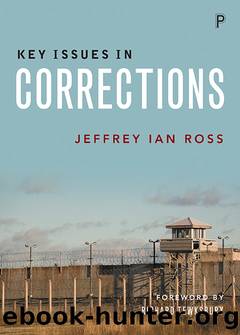Key Issues in Corrections by Ross Jeffrey Ian

Author:Ross, Jeffrey Ian [Ross, Jeffrey Ian]
Language: eng
Format: epub
Tags: Social Science, Criminology, Penology
ISBN: 9781447318750
Google: _hcwDwAAQBAJ
Publisher: Policy Press
Published: 2016-09-28T04:14:44+00:00
Conclusion
Most jails and prisons fail to adequately rehabilitate inmates, but this should not come as a surprise. The emphasis in jails and prisons is disproportionately on punishment, and the external benefit is supposed to be community safety. Still, as this chapter has outlined, there are opportunities for both administration- and convict-led efforts for prisoners to improve themselves. Also important are the numerous programs either run or assisted by outside volunteers. These exist in prisons like Graterford, Angola, and San Quentin. They help with health, literacy and job skills for prisoners.
One must guard against the perception that treatment effects are too idiosyncratic to allow for the implementation of programs with broadly positive effects. Although there are âresponsivityâ issues (individuals react differently depending on how a treatment is delivered), there is growing evidence (as noted earlier) that most people convicted of a crime are generally responsive to cognitive-behavioral interventions (Andrews et al., 1990).
Meanwhile, periodically, well-meaning individuals and organizations gain access to prisons and, with the blessing of the warden, senior correctional personnel, or the DOC, manage to get their ârehabilitativeâ programs implemented. Unfortunately, this âcorrectional quackeryâ often suffers from poor science. Their beneficial claims are based on anecdotal rather than empirical evidence. It is also difficult for such programs to compare the advantages of their experiment to other programs around the country. For example, it would be useful to know how the acquired skills and experiences transfer to something that is tangibly useful on the outside (Latessa et al., 2002).
Understandably, some rehabilitation programs work better than others, but no program works all the time â or even most of the time. The best success rate for the programs is only about 20 percent, and even this figure can be misleading. Different programs measure âsuccessâ in different ways. For some, success means a complete halt to criminal activity. The inmate, after his [sic] release, never again has a brush with the law. For others, an inmate may be considered rehabilitated if the ârateâ of his criminal activity declines: He may be rearrested (or reconvicted or reimprisoned) and still be considered ârehabilitatedâ so long as he is not rearrested as often as he might have been had he not participated in the rehabilitation program. The consensus is that programs that work best tend to be those that teach so-called life skills like balancing a checkbook and those that stress family involvement. (Hallinan, 2003: 133)
Download
This site does not store any files on its server. We only index and link to content provided by other sites. Please contact the content providers to delete copyright contents if any and email us, we'll remove relevant links or contents immediately.
Chaco's Northern Prodigies : Salmon, Aztec, and the Ascendancy of the Middle San Juan Region after AD 1100 by Paul F. Reed(355)
Law Enforcement Interpersonal Communication and Conflict Management by Brian Douglas Fitch(347)
Digital International Relations by Unknown(345)
Critical Perspectives on Human Security : Rethinking Emancipation and Power in International Relations by David Chandler; Nik Hynek(329)
Skilled interpersonal communication: Research, theory and practice, Fifth edition by Owen Hargie(326)
The Enduring Color Line in U.S. Athletics by Krystal Beamon Chris M. Messer(324)
Evidence-Based Policy Making in Labor Economics by Hamermesh Daniel S.;Nottmeyer Olga K.;Nottmeyer Olga;King Sarah;King Sarah;King Sarah;(297)
EPSO CAST Political affairs EU policies: How to succeed in the selection procedure by Franco Reverte José María(290)
Writing Public Policy - A Practical Guide to Communicating in the Policy Making Process by Catherine F. Smith(272)
Criminological Theory in Context by John Martyn Chamberlain(269)
Tibeton Yoga Its Secret Doc by Evans-Wentz(266)
Threshold Concepts in Women's and Gender Studies by Christie Launius Holly Hassel(263)
Rothschild and Early Jewish Colonization in Palestine (Geographical Perspectives on the Human Past) by Ran Aaronsohn(263)
Positive Psychology and Spirituality in Counselling and Psychotherapy (Conflict, Ethics, and Spirituality, 12) by unknow(261)
Social Problems, Social Issues, Social Science by James Wright(259)
Play in child development and psychotherapy: toward empirically supported practice by Sandra W. Russ(252)
Cognitive Development in Infancy and Childhood (Elements in Child Development) by Mary Gauvain(252)
Latin American Politics and Society by Gerardo L. Munck & Juan Pablo Luna(223)
What Makes a Social Crisis?: The Societalization of Social Problems by Jeffrey C. Alexander(220)
